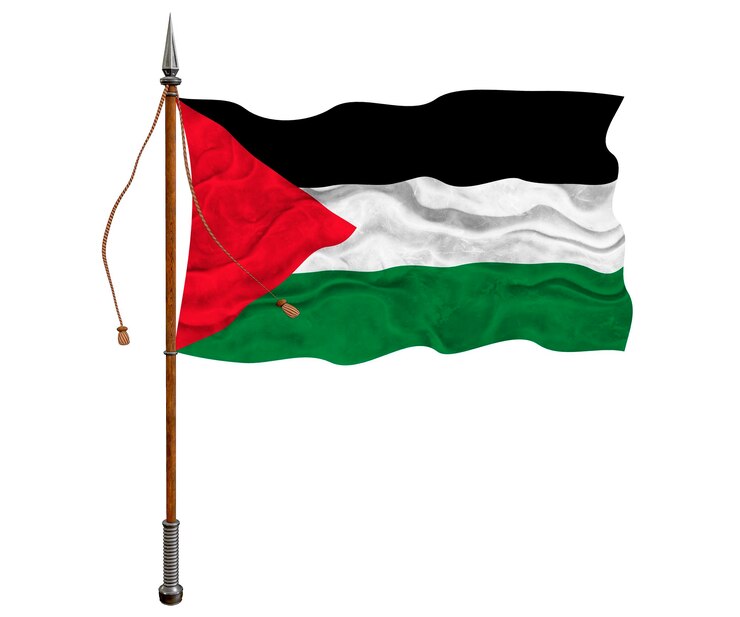Introduction to the Palestine Flag: History and Significance
Palestine flag is more than merely a piece of fabric fluttering in the wind. It is a powerful emblem representing the history, struggles, and aspirations of the Palestinian people. This blog post will take you on an enlightening journey through the origins and evolution of the Palestine flag, its design and symbolism, and its cultural and political importance. Whether you’re a history buff, a political enthusiast, or someone interested in the dynamics of international symbols, this post will offer valuable insights into the rich tapestry woven around this iconic flag.
Design and Symbolism of the Flag’s Colors and Patterns
The Palestine flag features a striking design that incorporates four colors—black, white, green, and red. Each color holds deep significance, embodying the spirit, history, and ideals of the Palestinian people. The flag consists of three horizontal stripes of black, white, and green, with a red triangle based at the hoist.
Black
The black stripe represents the Abbasid Caliphate and symbolizes the resilience and enduring struggle of the Palestinian people throughout history. It stands as a testament to their unwavering spirit in the face of adversity.
White
The white stripe signifies peace and the Umayyad Caliphate. It serves as a reminder of the Palestinians’ hope for peace and their pursuit of a harmonious coexistence with neighboring nations and cultures.
Green
Green is the color of the Fatimid Caliphate and has significant historical and religious connotations in Islamic culture. It symbolizes growth, prosperity, and the natural beauty of the Palestinian landscape.
Red
The red triangle represents the Hashemite dynasty and symbolizes the sacrifices and bloodshed for the cause of Palestinian liberation and self-determination. It underscores the deep-rooted desire for freedom and independence.
Evolution of the Flag: From Creation to Modern Representations
The Palestine flag has undergone several transformations since its inception. Its roots can be traced back to the Arab Revolt of 1916, during which it served as a symbol of unity and resistance against Ottoman rule. Over the years, the flag’s design has evolved to reflect the changing political and social landscape of Palestine.
Early Beginnings
The early versions of the flag were inspired by the flag of the Arab Revolt, which featured similar colors but in a different arrangement. These early flags embodied the spirit of Arab nationalism and the quest for self-determination.
Mid-20th Century Developments
In 1948, with the establishment of the State of Israel and the subsequent Palestinian displacement, the flag took on new significance. It became a symbol of the Palestinian people’s right to return to their homeland and their ongoing struggle for statehood.
Modern Representation
Today, the Palestine flag is recognized globally as the official flag of the Palestinian territories. It is a potent symbol of Palestinian identity and pride, representing the aspirations of millions of Palestinians worldwide.
Cultural and Political Significance of the Flag for Palestinians

Cultural Significance
The flag is prominently displayed during cultural events, national holidays, and commemorations. It is a symbol of Palestinian heritage and tradition, reflecting the rich cultural tapestry of the Palestinian people.
Political Significance
Politically, the flag represents the Palestinians’ quest for self-determination and statehood. It is a symbol of resistance against occupation and a call for international recognition of Palestinian sovereignty.
Symbol of Unity
The flag unites Palestinians across the globe, transcending geographical boundaries and political divisions. It serves as a rallying point for collective action and advocacy, reinforcing the sense of belonging and solidarity among Palestinians.
Use in Protests and Demonstrations
Activists and supporters of the Palestinian cause frequently use the flag during protests and demonstrations. It serves as a visual representation of their solidarity with the Palestinian people and their call for justice and human rights.
Artistic Representations
The flag has been incorporated into various forms of art, including paintings, murals, and digital media. These artistic representations highlight the flag’s symbolic power and its role in inspiring and mobilizing support for the Palestinian cause.
Controversies and Challenges Surrounding the Flag
Symbol of Division
Its association with the Palestinian struggle for statehood can be polarizing, evoking strong emotions and differing perspectives.
Challenges in Representation
Representing the diverse and multifaceted nature of Palestinian identity through a single flag can be challenging. The flag must balance the need for unity with the need to acknowledge the distinct experiences and aspirations of different Palestinian communities.
Conclusion: The Flag’s Role in Palestinian Identity and International Advocacy
The Palestine flag is more than just a national symbol; it is a powerful representation of Palestinian identity, culture, and political aspirations. It embodies the resilience, hope, and unity of the Palestinian people, serving as a beacon of their ongoing struggle for self-determination and justice.